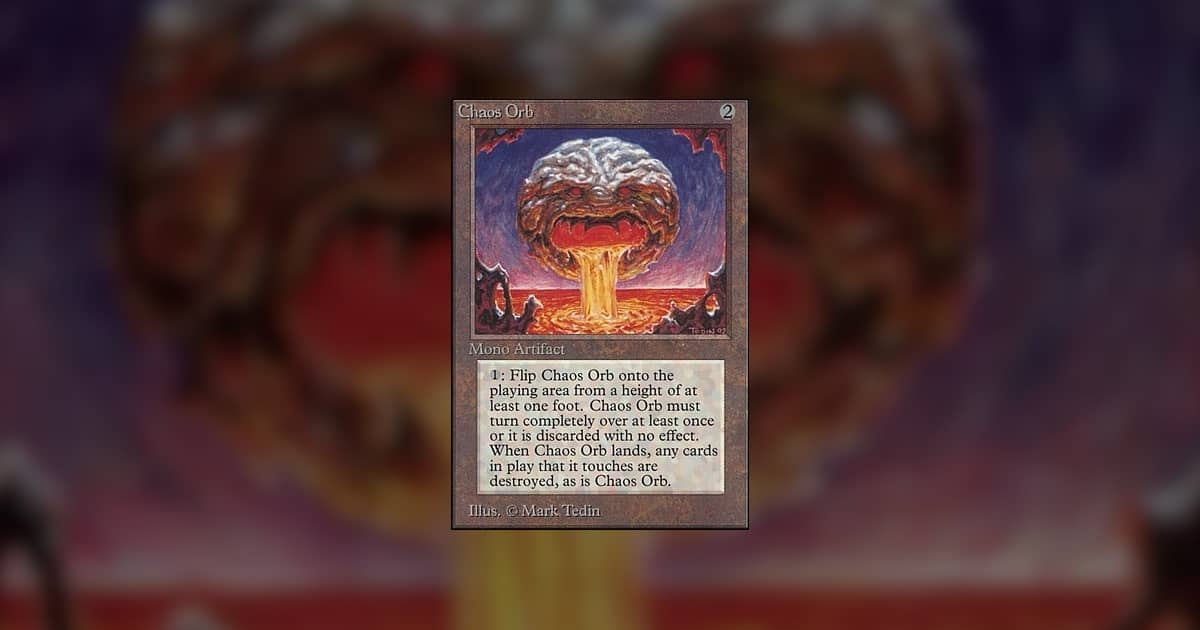Those who have played Magic: The Gathering for a while know that there are some insane card effects in the game, ranging from game-breakingly powerful to so random and chaotic one couldn’t help but ask who in their right mind designed this card and why?
Chaos Orb is both of those things. In fact, it’s so wild, bizarre, and chaotic, it recently made news, as a single copy hit over $10,000 on the PWCC card market. But what makes it so special that it rivals (and in some cases surpasses) The Power Nine – one of the most powerful and expensive cards in Magic: The Gathering – in price?
Chaos Orb – A True Embodiment of Chaos
This is a complicated question to answer, as there are a lot of factors to consider. Undoubtedly the most important one is the card condition. The particular copy on PWCC is listed as a PSA 10 Gem Mint condition, which essentially means that it’s undamaged. OK, very nice, but why is that so unusual? To the average card collector that won’t sound impressive, as one would think there’d be other PSA 10 Gem Mint condition copies. Not so with Chaos Orb. In fact, copies of such pristine condition were thought to be non-existent. To understand why, we need to look at the card’s game-breakingly overpowered and chaotic effect, which states:
If Chaos Orb is on the battlefield, flip Chaos Orb onto the battlefield from a height of at least one foot. If Chaos Orb turns over completely at least once during the flip, destroy all non-token permanents it touches. Then destroy Chaos Orb.
Banned for Good Reason
Yes, you read that correctly – Chaos Orb requires the player to physically flip the card into the air, from a height of at least one foot, like a coin. Not only that, it has to turn over completely (while in the air, mind you) at least once. After reading this, it’s no wonder why a PSA 10 Gem Mint condition of this card is such an insane idea – the very requirement to play the card is bound to damage it in some capacity – bent edges, chips, dents, and other forms of damage.
Air toss aside, the effect is insanely powerful. For just two mana (and a bit of luck) you can destroy an untold number of cards – a lot of players keep their lands close together, some even pile them up. Imagine hitting all of them with Chaos Orb, decimating their ability to generate mana.
Scenarios like these turn Magic: The Gathering into a game of luck rather than skill. Additionally, it is a nightmare to judge. Imagine calling out a judge to adjudicate the height from which the card was spun or whether or not it rotated completely. Such situations are extremely difficult to evaluate, let alone judge. This is exactly why the card is justifiably banned.
The Legend of the Chaos Confetti
The banning of Chaos Orb does not make it any less iconic, however. After all, it was first printed in the first Magic: The Gathering set – the Alpha set in 1993, and was fully playable until it was first restricted in 1994 in Wizards of the Coast’s first Banned/Restricted List., all the way until 1995 when Chaos Orb’s reign of chaos was extinguished by the ban hammer – almost 25 years ago.
The card’s iconic status has sparked legends, such as a supposed player ripping the Chaos Orb at a high-level tournament, turning the card into literal chaos confetti, which he then launched onto the cards of his opponent. The judges deemed the action legal but disqualified him anyway for now having a deck consisting of less than 60 cards. Some sources say it was Kai Budde, others say it was Mark Justice, but no one can actually confirm it. Nevertheless, the legend was so chaotic that it was immortalized in an iconic Magic: The Gathering card.

